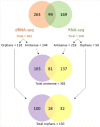Primary transcriptome analysis reveals importance of IS elements for the shaping of the transcriptional landscape of Bordetella pertussis
- PMID: 29683387
- PMCID: PMC6161684
- DOI: 10.1080/15476286.2018.1462655
Primary transcriptome analysis reveals importance of IS elements for the shaping of the transcriptional landscape of Bordetella pertussis
Abstract
Bordetella pertussis is the causative agent of whooping cough, a respiratory disease still considered as a major public health threat and for which recent re-emergence has been observed. Constant reshuffling of Bordetella pertussis genome organization was observed during evolution. These rearrangements are essentially mediated by Insertion Sequences (IS), a mobile genetic elements present in more than 230 copies in the genome, which are supposed to be one of the driving forces enabling the pathogen to escape from vaccine-induced immunity. Here we use high-throughput sequencing approaches (RNA-seq and differential RNA-seq), to decipher Bordetella pertussis transcriptome characteristics and to evaluate the impact of IS elements on transcriptome architecture. Transcriptional organization was determined by identification of transcription start sites and revealed also a large variety of non-coding RNAs including sRNAs, leaderless mRNAs or long 3' and 5'UTR including seven riboswitches. Unusual topological organizations, such as overlapping 5'- or 3'-extremities between oppositely orientated mRNA were also unveiled. The pivotal role of IS elements in the transcriptome architecture and their effect on the transcription of neighboring genes was examined. This effect is mediated by the introduction of IS harbored promoters or by emergence of hybrid promoters. This study revealed that in addition to their impact on genome rearrangements, most of the IS also impact on the expression of their flanking genes. Furthermore, the transcripts produced by IS are strain-specific due to the strain to strain variation in IS copy number and genomic context.
Keywords: bordetella pertussis; insertion sequence; transcriptome.
Figures




References
-
- Crowcroft NS, Stein C, Duclos P, et al.. How best to estimate the global burden of pertussis? Lancet Infect Dis. 2003;3:413–418. - PubMed
-
- Paddock CD, Sanden GN, Cherry JD, et al.. Pathology and Pathogenesis of Fatal Bordetella pertussis Infection in Infants. Clin Infect Dis. 2008;47:328–338. - PubMed
-
- World Health Organization Pertussis vaccines: WHO position paper - August 2015. Weely Epidemiol Rec. 2015;90:433–460.
-
- Sealey KL, Belcher T, Preston A. Bordetella pertussis epidemiology and evolution in the light of pertussis resurgence. Infect Genet Evol. 2016;40:136–143. - PubMed
-
- Kline JM, Lewis WD, Smith EA, et al.. Pertussis: a reemerging infection. Am Fam Physician. 2013;88:507–514. - PubMed
Publication types
MeSH terms
Substances
LinkOut - more resources
Full Text Sources
Other Literature Sources
